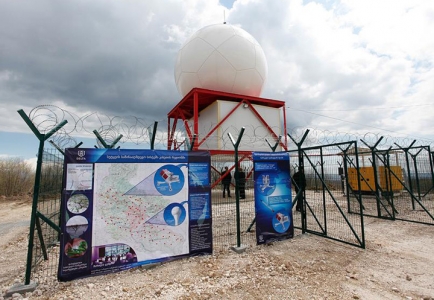
In this year’s June, not a single day has passed so far without State Military Scientific-Technical Center “Delta” publishing information about where, when and how effectively did its recently created rocket system defend Kakheti region’s villages from hail.
Although full avoidance of hailstorms was never achieved, the fact stands that Delta’s weather-altering rocket system has saved many Kakhetian vineyards from destruction. An impressive feat, considering that it isn’t even fully installed yet and its staff is still learning how to recognize cloud formations on the radar and plot precise firing solutions.
Delta’s new anti-hail complex consists of several separately located components: a meteorogical radar installed by Delta operatives at Chotori mountain near Nukriani village, an information processing and firing control center and several rocket batteries.
At the moment, 83 rocket batteries are being installed throughout Kakheti, following careful planning by Delta’s engineering and construction team. They will be controlled distantly, from the firing control center.
The batteries hold 26 rockets in sealed containers and are powered by solar panels. Panels are protected from damage by a layer of thick glass. Location of batteries was chosen in such a way that their operating zones overlap, leaving no gaps.
The missile’s range is 7 800 meters. Upon firing, the rocket reaches an altitude of 200m and upon reaching its mark, explodes, dispersing silver iodide, which makes clouds precipitate and disperse before they become dangerous. Silver iodide particles, when dispersed into a cloud, cause intense condensation of liquid around them, thus provoking rainfall. In case the cloudfront conceals a hailstorm, silver iodide prevents formation of hailstones.
In order to avoid accidents, activity of the rocket system will be coordinated with Sakaeronavigatsia, which monitors and manages traffic within the Georgian airspace.
Statistically speaking, people suffer the most damage from heavy rainfall and hailstorms. Farms, vineyards and other agricultural installations are near-defenseless against the elements and sometimes the damage caused by a single hailstorm can be measured in millions of lari. Hail can make efforts of farmers of an entire region null and void. And this is where the new system by Delta comes in.
In Georgia, need for hail protection is one-sided; it was by the request of Georgian Science Academy’s Geodesic Institute the first anti-hail rocket system was created in the Soviet Union in 1969. In the early 90’s, the anti-hail service became defunct and agricultural damage from the elements grew yet again. Now, creation of a new system gives us hope that our farmers’ harvests will finally be protected.
In comparison to “Alazani”, the Soviet system, “Delta’s” brainchild is far more efficient. This is mainly due to the fact that its reaction time is brought to a minimum, which is a decisive factor when it comes to combating cloudfronts.
Besides pure economic profit from the system’s use, there will most likely have significant political weight as well, since its successful implementation will elevate the image of the current government in the eyes of a certain part of Georgia’s population – namely, Eastern Georgian farmers and villagers. It is highly likely that members of the Georgian Dream party are aware of this, especially since the parliamentary elections of 2016 are approaching and the battle for the parliamentary majority promises to be fierce.
v-if="article.gallery" v-html="article.gallery"
(adsbygoogle = window.adsbygoogle || []).push({});